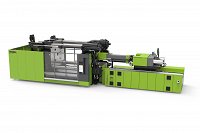Putting thermoplastic composites into series production faster
28.11.2018
Composite lightweight construction based on thermoplastics promises more efficient manufacturing processes and the recycling of obsolete components. Until the innovative materials and processes are used on a large scale some challenges still need to be solved and more experience needs to be gained. The National Composites Centre (NCC) in Bristol, UK, has set itself both these goals. An integrated manufacturing cell for overmoulding fibre-reinforced semi-finished products from ENGEL is paving the way for mass production in both automotive and aerospace industries.
 The automotive industry and aircraft construction have traditionally been among the most important industrial sectors in the United Kingdom, where composite research and processing has established itself to an equally high degree. Catapult plays an important role in this. Comparable to the Fraunhofer Society in Germany, Catapult bundles top-level application-oriented research in the United Kingdom and supports the industry to profit more quickly from new technologies. "We act as a kind of catalyst," says Paul Gallen, Sector Lead Automotive at NCC. The NCC is one of seven institutes which form the Catapult Network, each with its own thematic focus.
The automotive industry and aircraft construction have traditionally been among the most important industrial sectors in the United Kingdom, where composite research and processing has established itself to an equally high degree. Catapult plays an important role in this. Comparable to the Fraunhofer Society in Germany, Catapult bundles top-level application-oriented research in the United Kingdom and supports the industry to profit more quickly from new technologies. "We act as a kind of catalyst," says Paul Gallen, Sector Lead Automotive at NCC. The NCC is one of seven institutes which form the Catapult Network, each with its own thematic focus.
Founded in 2012, the NCC currently comprises 17,500 square meters with state-of-the-art manufacturing cells for a wide variety of composite technologies. More than 220 engineers and scientists employed there work closely with the University of Bristol, many other universities worldwide and above all with the industry. Companies – not only from the UK – use the capacities for their own development projects. "We are continuously comparing our roadmap with that of the automotive manufacturers," says Gallen. "The increased use of thermoplastic materials in lightweight composite construction is high on both agendas."
There are two main driving forces behind this development: "On the one hand, thermoplastic matrix materials enable efficient further processing of semi-finished products in an injection moulding machine and functionalization with materials from the same material group in a fully integrated, automated process," explains Christian Wolfsberger, Business Development Manager Composite Technologies at ENGEL's headquarters in Schwertberg, Austria. "Process integration and automation are the prerequisites for achieving the unit costs required by the high-volume automotive industry. On the other hand, thermoplastic composites simplify the subsequent recycling of components, which is in line with the trend towards circular economy."
The technological basis for the processing of thermoplastic fibre composites is expanding rapidly. A pioneering role is being taken by organo sheets, which are already being used in series production, particularly in the sporting goods industry. The first applications were recently launched in the automotive industry. "There is great potential," emphasises Graeme Herlihy, President Western Europe of ENGEL. "All OEMs and Tier 1 suppliers are working hard on this issue."
Flexible adaptability
For many companies in the composites industry, the trend towards thermoplastic materials means they have to deal with completely new processes. It is also the first injection moulding machine for the NCC. ENGEL supplied a duo 1700 large-scale machine including a Kuka articulated arm robot and an integrated infrared oven. "Many of the well-known automotive manufacturers and Tier suppliers have duo machines in their plants, and our partner institutes in the USA and Japan also work with this type of machine," says Gallen about the crucial point of relying on ENGEL’s technology and knowhow likewise. A second criterion was the flexibility offered by the ENGEL system solutions. The wide range of applications resulting from NCC research projects and company cooperation requires that the manufacturing cell can be adapted to new requirements, new materials and new technologies within a short time.
With a clamping force of 17,000 kN, the duo injection moulding machine is suitable for large components. In order to have a practical approach to development, the demonstrator moulds are based on the geometries of real car components. The sample parts have different sizes and complexities. So far, mainly organo sheets have been processed. These are heated in the infrared oven, inserted into the mould by the robot, formed there and then immediately overmoulded with plastic. "The fact that the infrared oven is located above the clamping unit simplifies handling and reduces the cycle time," reports Gallen.
Further developments focus on unidirectional (UD) fibre-reinforced tapes. With the help of these UD tapes, highly stressed areas in the component can be specifically reinforced in order to make even better use of the lightweight construction potential. "Today, the NCC is already a leader in the field of automated fibre laying, so the transition to UD tapes is not too far," says Gallen. With three differently dimensioned tape layup cells, the NCC is well equipped to produce the layups on site and process them further in an integrated process.
From product design to recycling
The NCC is an integrated factory, all processes can be developed and optimised in the overall context – from material development to simulation, design and processing to recycling. "The interfaces are particularly important when it comes to composites," explains Sean Cooper, Principle Research Engineer at the NCC. "In no other area are material, design and processing processes so closely intertwined. If you change only one of these three factors, you end up with a completely different result." It is also important for subsequent recycling to set the course already during product and process development. NCC is working with industrial partners on initial projects to develop value-adding recycling concepts. "The aim, for example, is to give safety-relevant components made of long-fibre-reinforced materials a second life as a bench or instrument panel based on materials reinforced with short fibres," says Gallen.
NCC developers have carried out many series of tests right from the start with materials typical of the automotive industry, primarily from the PA family, as well as with the high-performance plastics PEEK and PPS, which are preferably used in aircraft construction. "Over the last two years, the aircraft industry has been working intensively on what thermoplastic composites can do for them," reports Gallen. "The switch to thermoplastics often leads to a massively smaller CO2 footprint." It all starts with high-volume applications, which also certainly exist in aircraft construction. Fastening elements such as brackets, for example, which hitherto consist of aluminium. "At the end of the day, composites always compete with steel or aluminium," says Paul Gallen. "Composites can only be used if the parts are even lighter, the unit costs even lower and the production processes even more efficient. Our goal is to additionally obtain even better component properties."




































